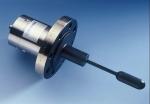A new sensor style from Marimex Industries Corp. now extends its application base into the mining industry.
This sensor is based on a standard Marimex design but employs a special coating to inhibit the abrasive conditions often found in the mining industry. Previously such sensors have already been used without coating in similar industries like cement and concrete applications, where abrasion is also very high. The use of this special coating is expected to extend the lifetime of the sensor.
As environmental impacts are being felt around the world, it is also felt in the mining industry especially as it applies to water usage. In many areas water has become a precious resource and steps need to be taken to limit use of water. Viscosity measurement can assist in determining and limiting such water usage as an example in tailings streams. Already a relatively small additional amount of water to a tailings stream will lower the viscosity of the stream by an amount measurable with a Marimex viscometer. Marimex viscometer sensors provide a high resolution measurement in process and yet are rugged for the application. Different styles are available to cover a wide range of measurement. Every system is factory calibrated and capable to measure over multiple decades of viscosity. Systems can be easily field configured to measure 1% of the calibrated range as a full range yet again with the resolution still being 1% of the configured range. No change or physical modification to the sensor is required. A configuration change on the transmitter is all that is required.
Together with the introduction of this new sensor Marimex is also introducing new electronics. Based on the proven technology of the model VS-4450 the new model VS-D250 reduces both the size and the price of the transmitter. This has been achieved by repacking the electronics and leaving off a few capabilities, which are often not required in some applications. The model VS-D250 is housed in a DIN rail housing and can easily be mounted in a back panel rather than taking up front panel space. It is capable to carry two output cards which are available as 4 to 20 mA analog outputs or RS485 and RS232 serial outputs. An additional RS232 output is available on the front plate as well and can be used for all included Modbus capabilities including configuration via a computer. Power supply for this transmitter is 24 VDC, which makes it easy to be connected to a non-interruptible 24 VDC power supply. A model VS-C250 with the similar capabilities as the model VS-D250 is also available. This model is for insertion directly into a sensor. however due to the mounting inside the sensor, this electronics can only be configured via a computer, whilst the model VS-D250 can also be configured by hand via three push buttons.

